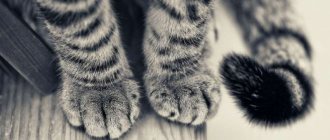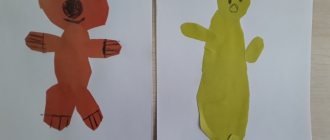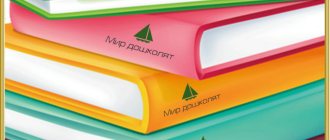Summary of a subgroup speech therapy lesson for children with ODD. Topic: Trees.
\
Summary of a subgroup speech therapy lesson for children with ODD
Theme: Trees
Krasilnikova A.I.
teacher speech therapist
Yuzhno-Sakhalinsk
2015
Summary of a subgroup speech therapy lesson for children with ODD. Topic: Trees.
Program content:
- Expand and activate the vocabulary on the topic: “Trees.”
- Improve the grammatical structure of speech.
- Learn to characterize sounds according to the degree of softness and hardness.
- Learn to form nouns with a diminutive meaning.
- Develop phonemic awareness.
- Develop visual perception
- Develop fine motor skills of the fingers.
- Foster respect for the environment and love for nature.
Equipment:
pine cones, mugs with sound designations, caps of different colors (red, blue, green), pictures of trees and leaves.
Progress:
- Organizing time
. Hello guys! Now the one who calls his name affectionately will sit down.
- Development of fine motor skills
.
Children roll pine cones between their palms and say:
“At the pine, at the fir, at the Christmas tree
Very sharp needles.
But even stronger than the spruce forest.
The juniper will prick you!”
- Recalling the topic of the previous lesson.
Let's remember what we talked about in the last lesson?
- Phonetic analysis.
Guys, let's remember what sounds there are? (correct vowels and consonants).
What vowel sounds do you know? What color do we use to indicate vowel sounds?
What are the consonant sounds? (correctly hard and soft, what color do we use to indicate hard? Soft?)
Let's learn the rule:
Before A, O, U, E, Y - all consonants are hard.
Before I, E, Yo, Yu, I - all consonants are soft.
Sound analysis of words: leaf, oak, pine. Children characterize the sounds and lay out a diagram of the caps (red - vowel sound, blue - hard consonant, green - soft consonant).
- Introduction of the topic of the lesson.
Guys, I’ll tell you a riddle, and you guess it and tell me what the topic of our lesson is today.
We saw him dressed in spring and summer.
And in the fall, all the poor girl’s shirts were torn off. (tree)
How did you guess that this was a tree? What kind of trees do you know? What types of trees are there? (coniferous and deciduous). We look at the pictures and get acquainted with the trees.
- Game "Telephone".
The speech therapist quietly tells the child the names of 3 trees, and he whispers these names to another. (oak, maple, pine), (spruce, ash, birch).
- Physical exercise “We are autumn leaves.”
We are autumn leaves
(Smooth swinging of arms above your head.) We are sitting on the branches. The wind blew and they flew. (Hands to the sides.) We flew, we flew, and sat quietly on the ground. (Sat down.) The wind came again and picked up all the leaves.
(Smooth swinging of the arms above the head.) They spun, flew, and sat down on the ground again. (Sit down.)
- Game "Name the leaf".
At the maple-
At the birch-
At the willow-
At the poplar-
At the rowan-
At the oak-
- Game "Count to 5"
Example: one maple leaf, 2 maple leaves, 3 maple leaves, 4 maple leaves. 5 maple leaves.
- Development of visual perception. Which leaves are hidden?
- Reflection What trees do you remember? Let's remember the seasons? Autumn months?
Bibliography
1. Krupenchuk O.I. Teach me to speak correctly! / A manual on speech therapy for children and parents. – St. Petersburg: Litera Publishing House, 2005. – 208 p.
2. Ishchenko M.N. Physical exercise for kids Publisher: Phoenix, 2009
LiveInternetLiveInternet
Quote from Tatyana57
Read in full In your quotation book or community!
SPEECH DEVELOPMENT. LEXICAL TOPIC “TREES AND SHRUBS”.
CHILDREN SHOULD KNOW THE NOUNS: rosehip, currant, raspberry, barberry, hawthorn, thorns, lumps, clusters, berries, aspen, rowan, linden, apple tree, spruce, pine, birch, buds, branches, trunk, leaves, fruits, seeds, earrings , crown, top, bark, roots, cones. ADJECTIVES: white-trunked, slender, tall, low, elegant, beautiful, large, carved, birch, spruce, rustling, rough, branched, evergreen, spreading, small, green, yellow, red, prickly, smooth, round, oblong, sweet, sour, ripe, bitter, hard, soft, juicy, healthy, medicinal. VERBS: prickly, grow, stand, sway, fall, ripen, sway, pick, collect, bloom, decorate, fly, crumble, make noise, plant, tremble, water, fertilize, protect. CHILDREN SHOULD BE ABLE TO FORM ADJECTIVES FROM NOUNS: Birch - birch. Spruce - spruce. Rowan - rowan. Pine - pine. Aspen - aspen. Currant - currant. Linden - lime. Apple tree - apple tree. CHILDREN SHOULD BE ABLE TO DESCRIBE TREES (SHRUBS) BY QUESTIONS: What is the name of this tree? Tree or shrub? How big is it? Where does it most often grow? What parts does it consist of? What kind of tree trunk does it have? (thick, thin, tall, short...) What kind of bark does the tree have? (dark, light, smooth, rough...) What shape are the leaves? (round, oval, carved, elongated, needles...). How can it benefit people? How does it change at different times of the year? What can be made from this tree? Why do people plant trees on city streets? TO DISTINGUISH A TREE FROM A BUSH BY SIGNS: An adult tree is taller than a bush. The tree has one trunk.
A STORY ABOUT THE BIRCH. This is a birch tree. She has a white, thin, slender trunk. The branches have round leaves. The birch tree feeds with the help of its roots. Birch is a large deciduous tree. Most often it grows in the forest. In the city, people plant birch trees to make the air clean. Various crafts are made from birch bark. In spring, buds appear on the birch tree and turn into leaves. The birch tree remains green all summer. In autumn the leaves turn yellow and fall off. In winter, bare branches are covered with snow.
All plants can be divided into three groups: trees, shrubs and herbs. Trees are the largest and longest-living representatives of living nature. They are as tall as a ten-story building. The tree consists of three main parts. The roots hold it in the ground and absorb water and mineral salts from the soil. The trunk and branches carry the sap and lift the leaves towards the sun. The tree becomes taller and wider due to the growth of shoots and branches at the top. The trunks of all trees are covered with bark, which protects the delicate interior of the tree from drying out and various damage.
Trees are deciduous and coniferous. Deciduous trees shed their leaves in the fall and the leaves appear again in the spring. Deciduous trees include willow, linden, maple, oak, birch, and poplar.
Coniferous trees have long thin needles instead of leaves, which are called needles, and they do not shed them in the fall, but remain with the needles all year round. In spring, coniferous trees, along with old needles, produce new young needles. That's why coniferous trees are always green. Coniferous trees include fir, spruce, and pine.
Shrubs are similar to small trees, but differ from them in that they do not have one thick trunk, like a tree, but several thin trunks connected together at the base. WHAT ARE TREES FOR, THE BENEFITS OF TREES: Trees purify and moisten the air, create coolness, and some produce delicious edible fruits. Sawn wood is a building material: dried trunks are used to make boards, plywood, furniture, toys, and paper. Trees grow slowly, so they need to be protected. We need to protect the trees, take care of them, sometimes talk to them kindly, and in the spring, plant young trees together with our parents. CONVERSATION ON QUESTIONS: What trees do you know? (deciduous and coniferous). Where do trees grow? What types of forests are there? (If pine and spruce trees grow in the forest, then this forest is coniferous. If oaks and aspens grow in the forest, then this forest is deciduous. If spruce, birch and oak trees grow in the forest, then this forest is mixed. If birch trees grow in the grove, then this is a birch grove. If oaks grow in the grove, then it is an oak grove. If maples grow in the grove, then this is a maple grove.) Why are they called that? What does the tree have? (Root, trunk, branches, leaves (needles), crown, fruits.) Are trees different from shrubs? How? Are trees living or non-living? Who (or what) helps them grow? GAME “WHOSE FRUITS?” Acorns grow on... oak; clusters of rowan grow on - rowan; apples grow on an apple tree; catkins grow on birch, alder; round cone on a pine tree; long cone on - spruce. Etc. GAME “NAME IT AFTERLY.” Spruce - Christmas tree. Pine - pine. Birch - birch. Needle - needle. Branch - twig. A lump is a lump. GAME "GUESS WHICH TREE I'M TALKING ABOUT?" Slender, curly, white-trunked... (birch) Sad, sad, weeping... (willow) Slender, green, prickly... (spruce) Strong, mighty, spreading... (oak). READING A STORY. There was a spruce tree growing near the house. There were cones on the spruce tree. Lena was collecting cones in a bag. Lena gave the cones to her mother. Mom made toys out of cones. CONVERSATION ON QUESTIONS. Where did the spruce grow? What did mom make from the pine cones? What kind of toys could you make from pine cones? RETELLING OF THE RIDDLE ABOUT TREES: It makes you happy in the spring, It cools you in the summer, It nourishes you in the fall, It warms you in winter. (Tree) The bee takes the most delicious honey from my flower. But they still offend me: They tear off my thin skin. (Linden tree) I have longer needles than a Christmas tree. I grow in height very straight. If I'm not at the edge, the branches are only at the top. (Pine) Like pines, like fir trees, And in winter without needles. (Larch) Turned green in spring, tanned in summer, wore red corals in autumn. (Rowan) A Russian beauty stands in a clearing, wearing a green blouse and a white sundress. (Birch) She lowered her curls into the river and became sad about something, but what she is sad about doesn’t tell anyone. (Willow) You will find her in the forest, Let's go for a walk and meet her. Stands prickly like a hedgehog, In winter in a summer dress. (Spruce) In summer - snow! Just laughter! Snow is flying around the city, why doesn't it melt? (Pople fluff) No one is scared, but everyone is trembling. (Aspen)
Series of messages “Speech Development”:
Part 1 - POSTER. BERRIES. Part 2 - SPEECH DEVELOPMENT. LEXICAL TOPIC “POWERIES”. ... Part 12 - SPEECH DEVELOPMENT. LEXICAL TOPIC “GIFTS OF AUTUMN”. Part 13 - SPEECH DEVELOPMENT. LEXICAL TOPIC "BERRIES". Part 14 - SPEECH DEVELOPMENT. LEXICAL TOPIC “TREES AND SHRUBS”. Part 15 - SPEECH DEVELOPMENT. RIDDLES ABOUT BERRIES. Part 16 - SPEECH DEVELOPMENT. RUSSIAN FOLK TALE “MASHA AND THE BEAR”. HOME THEATER. Part 17 - SPEECH DEVELOPMENT. RIDDLES ABOUT VEGETABLES. Part 18 - SPEECH DEVELOPMENT. RIDDLES ABOUT FRUIT.



